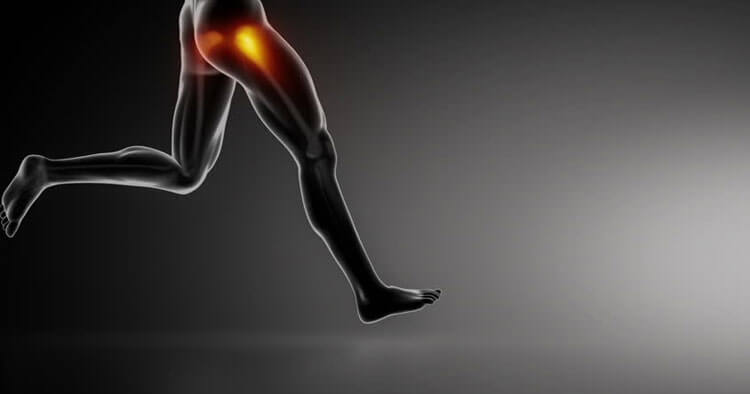Muscle Pain and Tendinopathy
Lateral Hip Pain Diagnosis And Management
Symptoms Of Gluteal Tendinopathy
Gluteal tendinopathy is a common cause of lateral hip pain and presents with a number of symptoms, common symptoms may include:
- Pain, or a feeling of tightness at the side of the hip. This pain can refer away from the hip and will sometimes run down the outside of the thigh, towards the knee.
- Pain sleeping, when lying on the affected side, where there is direct compression of the gluteal tendons this can cause the individual to experience pain and disturbed sleep. Conversely lying on the non-affected side where the sore leg is upper most in this position the sore leg can fall across the body resting, or hanging in a position of stretch for the gluteal tendons. Either of these positions can provoke lateral hip pain during the night disturbing sleep, or leave the individual with a sensation of stiffness when rising from bed in the morning.
- Pain sitting for extended periods, often this pain is noticed when the individual then rises from their chair and moves and the hip is uncomfortable and/or stiff. Sitting with legs crossed is often more uncomfortable for people with gluteal tendinopathy as this posture can place the tendons in a position of sustained stretch.
- Pain running, with running the pain is often felt during the impact phase, when the foot strikes the ground and as the tendons have to work to help stabilize the body as weight moves over top of the foot.
- Pain when hopping, or if pelvic control is poor, or pain in significant, people will often feel pain even when simply standing in a posture maintaining single leg balance control on the affected side.
- Pain when walking up, or down hills, or stairs.
Diagnosis Of Lateral Hip Pain
The hip is often a complex area to make a diagnosis in, there are a number of other structures and conditions that can be the cause of lateral hip pain, presenting with similar symptoms to gluteal tendinopathy, including conditions such as osteoarthritis of the hip and bursitis.
Gluteal tendinopathy as a diagnosis is frequently missed, often incorrectly diagnosed as hip bursitis (mentioned above). The management of lateral hip pain where the source of the pain is the result of brusitis, verses gluteal tendinopathy varies. Bursitis is often effectively treated with cortisone injections to reduce pain and inflammation in the bursae, however using the same injections for gluteal tendinopathy as a cause of lateral hip pain could potentially cause further degeneration of the tendon. And although cortisone injections in many situations may offer a temporary relief in symptoms with gluteal tendinopathy, as a rule cortisone injections are not the preferred course of management for tendinopathies.
I would like to think that the majority of the time a physiotherapist will accurately diagnose gluteal tendinopathy in the clinic, without the need for any medical investigations. However if the symptoms are severe, or the individual fails to improve at a satisfactory rate then investigations such as an ultrasound scan, or MRI may be requested to help guide the best treatment approach.
Treatment For Gluteal Tendinopathy
Management Of Lateral Hip Pain In The Acute Situation: When tendon tissue is first aggravated, or re-aggravation of a chronic situation (an acute reactive tendon, or an acute-on-chronic reactive tendon pain) the most important factor is typically the reduction of load on the gluteal tendons. Coupling this with application of local treatment, to promote healing, or the calming of pain and working on improving hip and pelvic control to help create a smooth transition back into loading.
Unloading will often involve avoiding activities like running or jumping, as well as avoiding activities which place stretching load on the tendons (this includes mainly movements where the hip is adducted across the body, such as crossing your legs). Stretching motions are generally avoided with gluteal tendinopathy, as stretching the gluteal muscles, or superficial to the tendons the ITB, can potentially increase the compression on the tendons causing further aggravation.
Tip: If it feels like the gluteal muscles, or ITB are tight, or there are some trigger points present that you feel the need to relieve, then getting a massage, or the use of a foam roller on the these areas can be beneficial. However, at least in the acute reactive stage of lateral hip pain it is generally best to avoid directly massaging, or rolling on the gluteal tendons, so not to cause more compression and swelling to the painful tendon complex.
Management Of Lateral Hip Pain In The Subacute / Chronic Stages: Similar to in the acute and reactive stages, load to the tendon still needs to be managed, achieved via avoiding aggressively and repetitively stretching of the area and graduating any return to activity. However, at this stage your physiotherapist can progress any in-clinic and home exercises moving from lower stress isometric, through to eccentric loading exercises to the tendon. Progressing any exercises introduced in the reactive stage, still focusing on working to achieve good pelvic control whilst improving the load tolerance of the tendon. Sometimes your physiotherapist may consider the application of passive therapies including, shockwave therapy, or dry needling, or similar in this degenerative phase. Employed at the right phase these passive therapies can be beneficial in improving tissue mobility, assisting healing and pain management, ultimately helping accelerate a return to pre-injury activity levels.
Disclaimer: Sydney Physio Clinic provides this information as an educational service and is not intended to serve as medical advice. Anyone seeking specific advice or assistance on Lateral Hip Pain Diagnosis And Management should consult his or her general practitioner, sports medicine specialist, orthopedic surgeon, physiotherapist or otherwise appropriately skilled practitioner.


